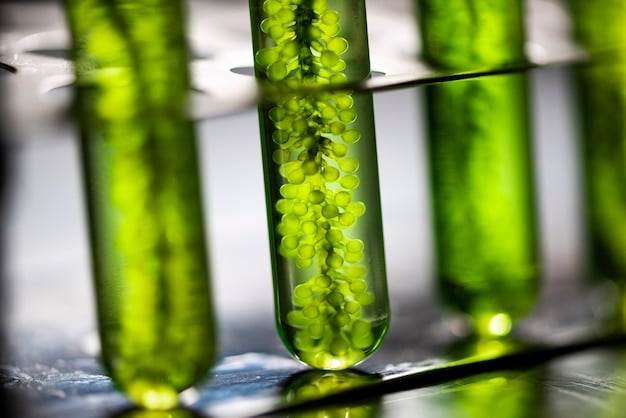Sustainable Aviation Fuel (SAF): US Airlines’ Path to Carbon Reduction

Sustainable Aviation Fuel (SAF): How US Airlines Are Reducing Their Carbon Footprint by 28% with New Technologies involves airlines embracing innovative solutions like SAF to significantly lower emissions and contribute to a greener aviation sector, showcasing the industry’s commitment to environmental sustainability.
The aviation industry, often criticized for its environmental impact, is taking significant strides towards sustainability. Sustainable Aviation Fuel (SAF): How US Airlines Are Reducing Their Carbon Footprint by 28% with New Technologies represents a pivotal shift, showcasing the commitment of US airlines to reduce their environmental impact and embrace a more sustainable future.
What is Sustainable Aviation Fuel (SAF)?
Sustainable Aviation Fuel (SAF) is not just another biofuel; it represents a transformative approach to powering aircraft. It’s designed to be a direct replacement for conventional jet fuel, but with a significantly reduced carbon footprint.
SAF can be produced from a variety of sustainable sources, offering a pathway to decarbonize air travel.
The Key Differences Between SAF and Conventional Jet Fuel
Unlike traditional jet fuel, SAF is derived from renewable and sustainable sources, greatly lowering its carbon emissions.
- Feedstock: SAF is made from sustainable sources such as algae, non-food crops, or waste biomass.
- Carbon Footprint: SAF emits up to 80% less carbon dioxide over its lifecycle compared to conventional jet fuel.
- Compatibility: SAF is designed to be a “drop-in” fuel, meaning it can be mixed with traditional jet fuel and used in existing aircraft without requiring modifications.

SAF offers immediate environmental benefits and long-term sustainability for US airlines.
The Environmental Imperative
The aviation sector has a considerable impact on global carbon emissions. Airlines are addressing global warming and the need for more sustainable travel solutions by investing in sustainable airplane fuel.
There is growing pressure for airlines to proactively reduce their carbon footprint and support a more environmentally responsible aviation landscape.
The Environmental Impact of Aviation
Aviation contributes significantly to global greenhouse gas emissions, necessitating urgent action.
- Carbon Emissions: Airlines are responsible for approximately 2-3% of global carbon emissions.
- Climate Change: These emissions contribute to global warming and climate change effects.
- Public Pressure: Governments and the public are pushing for sustainable aviation practices.
Sustainable solutions are essential for airlines worldwide to operate sustainably.
How US Airlines Are Embracing SAF
US airlines are at the forefront of integrating sustainable aviation fuel (SAF) into their operations. They are actively investing in, testing, and deploying SAF to reduce carbon emissions and promote sustainable air travel.
SAF is becoming increasingly important as airlines prioritize environmentally conscious solutions.
United Airlines’ Commitment to SAF
United Airlines has showcased a strong dedication to sustainability through their significant investments in SAF, illustrating a move towards greener aviation methods.
United’s Eco-Skies Alliance initiative is a critical factor in promoting environmental sustainability and reducing carbon footprint.
JetBlue’s Utilization of SAF
JetBlue has become an early adopter of SAF, integrating it into its fuel supply at several of its airport hubs, notably Los Angeles International Airport (LAX).
Utilizing sustainable aviation fuel, JetBlue reduces greenhouse gas emissions, leading to improved air quality and environmental sustainability.

US airlines are dedicated to adopting eco-friendly strategies, leading the way in establishing SAF as a viable means of advancing sustainability in the aviation sector.
New Technologies Driving SAF Production
A variety of new technologies are driving the production of SAF, making it more efficient, cost-effective, and environmentally friendly. New technologies are making SAF more economical and eco-friendly.
SAF is becoming increasingly viable. The continuous development of new technologies provides promising methods for refining sustainable aviation fuel, expanding SAF production.
Alcohol-to-Jet (AtJ) Technology
One of the most promising technologies is Alcohol-to-Jet (AtJ), which converts ethanol into jet fuel. This process allows for the use of various feedstocks, including waste biomass and non-food crops.
Power-to-Liquid (PtL) Technology
Power-to-Liquid (PtL) technology uses renewable energy to convert water and carbon dioxide into synthetic fuels. This process is carbon-neutral and offers a sustainable pathway to producing SAF.
Innovative methods and technologies increase the sustainability and cost-effectiveness of airplane fuels.
The Impact of SAF on Carbon Footprint Reduction
The use of SAF has a direct and significant impact on reducing the carbon footprint of airlines. By switching from traditional jet fuel to SAF, airlines can substantially lower their greenhouse gas emissions and contribute to a more sustainable future.
SAF is crucial in reducing the airline industry’s environmental effect.
Lifecycle Emissions Reduction
SAF can reduce lifecycle greenhouse gas emissions by up to 80% compared to conventional jet fuel. This reduction takes into account the entire process, from feedstock production to fuel combustion.
The Role of Government Incentives
Government incentives, such as tax credits and grants, play a crucial role in promoting the production and adoption of SAF. These incentives help to offset the higher costs associated with SAF and encourage airlines to invest in sustainable solutions.
SAF’s effect is enhanced through government incentives, propelling carbon footprint reductions in airlines.
Challenges and Opportunities
Despite its promise, the widespread adoption of SAF faces several challenges. These are the challenges and possibilities for sustainable aviation fuel.
Addressing these hurdles is crucial for realizing the full potential of SAF in decarbonizing the aviation industry.
Scalability and Cost
One of the main challenges is scaling up SAF production to meet the demand of the aviation industry. The current production levels are relatively low compared to the total jet fuel consumption.
Policy and Regulatory Support
Strong policy and regulatory support are essential for creating a stable and predictable market for SAF. Governments can implement policies that incentivize SAF production and use, such as mandates, tax credits, and carbon pricing mechanisms.
Overcoming problems and utilizing chances in SAF production is critical for its success.
| Key Point | Brief Description |
|---|---|
| 🌱 Origins of SAF | Derived from algae, waste biomass, and non-food crops. |
| 📉 Carbon Reduction | Reduces lifecycle emissions by up to 80% compared to jet fuel. |
| ✈️ Airline Adoption | United and JetBlue are integrating SAF into operations. |
| 🧪 Tech Advances | AtJ and PtL are making SAF more efficient. |
FAQ Section
▼
SAF is a biofuel designed as a drop-in replacement for conventional jet fuel, made from sustainable sources and reducing carbon emissions.
▼
SAF can reduce lifecycle greenhouse gas emissions by up to 80% compared to conventional jet fuel, significantly decreasing the environmental impact.
▼
United Airlines and JetBlue are among the leading US airlines using SAF, incorporating it into their operations and supply chains to promote sustainability.
▼
Technologies like Alcohol-to-Jet (AtJ) and Power-to-Liquid (PtL) are key drivers, making SAF production more efficient and utilizing a variety of sustainable feedstocks.
▼
Challenges include scalability, high production costs, and the need for strong policy and regulatory support to create a stable market for sustainable aviation fuel.
Conclusion
In conclusion, the adoption of Sustainable Aviation Fuel (SAF): How US Airlines Are Reducing Their Carbon Footprint by 28% with New Technologies, supported by continuous innovation and robust policies, offers a promising path to a greener aviation sector and a more sustainable future.





